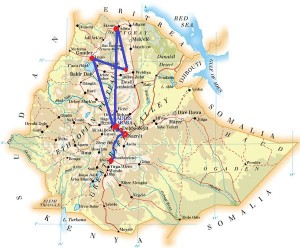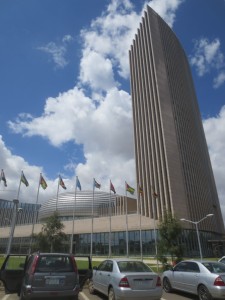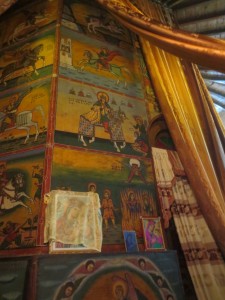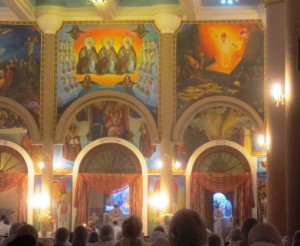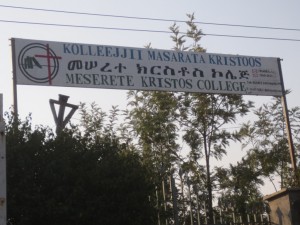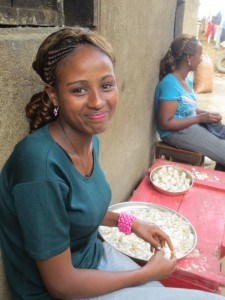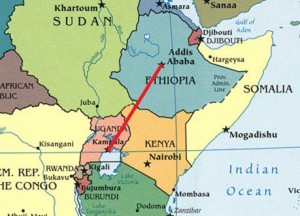After our trip towards the south we spent two nights in Addis Ababa (more later) and then flew north to visit historical sites in Axum, Lalibela, and Gondar.
Axum was the capital of a vast territory that stretched from Sudan across to Yemen for thousands of years (B.C.). Axum is only 35 km from present-day Eritrea. According to oral tradition, Ethiopia was settled by Ethiopic, the great-grandson of Noah. Ethiopic’s son, Aksumai, founded the capital of Axum and also a dynasty of rulers that lasted for between 52 and 97 generations.
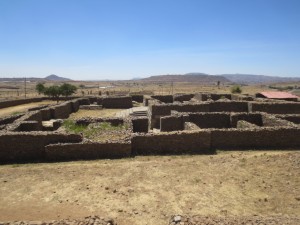
Queen of Sheba palace ruins
The last and greatest of these monarchs was Queen Makeda who lived in the 11th and 10th centuries BC. Today we know Queen Makeda as the Queen of Sheba. The Ethiopian version of the story is an intriguing tale which suggests that Ethiopian royalty has descended from a union between King Solomon and the Queen of Sheba. The Queen returned to Axum and gave birth to their son Menelik. At the age of 22 Menelik returned to Jerusalem and stayed for 3 years. There is a more lengthy story but, in short, when he left Jerusalem he “stole” the Ark of the Covenant and took it to Axum where it is now located. The story of the Ark is very important in Ethiopian Orthodox as it has travelled to several spots in Ethiopia during times of turmoil. Every Orthodox church has a replica which is brought out in the public during important days—but no one is allowed to see the original ark. We visited Queen of Sheba’s palace and also her bath located 9 kms from her palace. Another important person was King Ezana who brought Christianity to Axum in the 4th century AD from Alexandria. The Axumite kingdom was also notable for introducing Ge’ez, the first universal written language in Africa. This language was used in church writing and manuscripts until the 19th century and spawned the Amharic language. The dynasty beginning with Menelik continued to Haile Selassie in the 20th century AD.
On a hilltop about 2km north of Axum we visited two underground tombs of Emperor Kaleb and his son and successor Gebre Meskel who both ruled in 6th century AD. We also looked in on the tunnel that these people had dug from Axum to the Red Sea—a length of 294 km with a shaft every 20 metres.
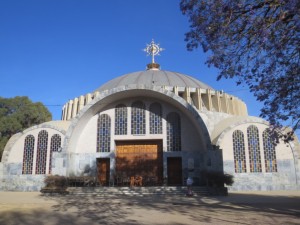
St Mary of Zion church
We visited the Cathedral of Tsion Maryam (St Mary of Zion) in Axum which was built by Haile Selassie in the 1950s. It is on this compound that supposedly the Tabot or Ark of the Covenant is kept. The wall frescos were beautiful. They had an old Bible with beautiful paintings. Near the Cathedral is the stelae field with enormous stelae, each carved from single blocks of limestone– some up to 25 metres high and up to 500 tons. One wonders how they ever were erected. They were built to mark tombs.
Lalibela is an isolated town high in the mountains and is famed for its rock-hewn churches. Lalibela was the capital of Ethiopia from the 10th century to the mid 13th century. King Lalibela was inspired to carve these churches in a period of 24 years gathering craftsmen and artisans. Legend has it that at least one of the churches was built in a day with the help of angels. Other sources say it would have taken 40,000 people to carve them. They were carved from the top down and some were quite intricate for stone carvings.
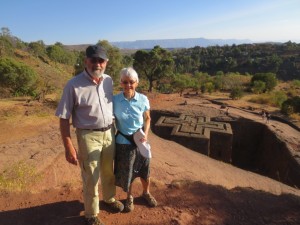
St George church
There is much symbolism in the churches and their placement. There are three groups of churches—the first group represent the earthly realm, the second group represent heavenly paradise, and the third represents Noah’s Ark and is dedicated to St George. “Jordan River” runs between the first and second group of churches. To enter the heavenly group of churches one enters a 50-foot tunnel. It was completely dark and we felt our way by touching one side of the tunnel. The story is that one can feel how hard it is to enter heaven!
Gondar was the capital of Ethiopia during the 17th and 18th centuries. We visited Fasiledes Castle built by King Fasiledes the founder of Gondar. The complex contains six castles, some connecting tunnels and raised walkways and several smaller buildings. Some of the buildings were partially destroyed during World War II and some were partially restored through UNESCO funding.

Fasiledes Castle
Fasilida’s Pool is a sunken bathing pool. It is referred to as a swimming pool but is dry except during the Timkat or Epiphany Festival (18-20 January). At that time thousands of white-robed worshippers converge around the pool where they are blessed and swim or are sprinkled with its holy water. Banyan trees from Cambodia grow along several of the high walls.
There are said to be 44 churches in Gonder but most of the original buildings were destroyed in 1888 when Gonder was attacked by the Dervish of Sudan. The only Gonderine church that escaped entirely untouched was Debre Birhan Selassie (“Mountain of the Enlightened Trinity”), saved from the Dervish by the intervention of a swarm of bees – so says legend.
When we visited the Selassie Church a funeral was being performed. Masses of people were chanting on the road (along with the casket) when we arrived. Then the men went through the gate to the courtyard. More chanting and a trip around the church carrying the casket. During this time, a group of men with instruments were in the doorway of the church “singing.” The
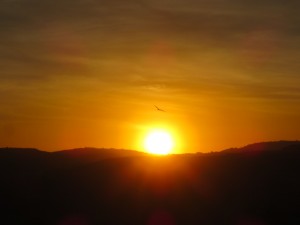
Gondar sunset
bright umbrellas were fascinating. The church itself is known for the prolific paintings inside. All walls and ceiling were covered with various scenes from the Life of Christ and of saints.
Supper was at a hotel in Gondar above the town with a gorgeous sunset to the west and a full moon to the east. (Sally Jo finds the history of Ethiopia fascinating and has a hard time being succinct!)
-

-
78-passenger plane
-

-
view near Axsum
-

-
camel
-

-
tomb entrance
-

-
burial chamber
-

-
Queen of Sheba palace ruins
-

-
Queen of Sheba baths
-

-
St Mary of Zion church
-

-
Orthodox music demonstration
-

-
Illustrations in old Orthodox Bible
-

-
Stelae
-

-
Large stele
-

-
View near Lalibela
-

-
Rock-hewn church
-

-
Shoes removed to enter Orthodox churches
-

-
Interior of rock-hewn church
-

-
rock-hewn church
-

-
various window designs
-

-
Interior details
-

-
Interior details
-

-
Interior details
-

-
pathway between church and mother rock
-

-
“men only” room
-

-
Interior bas-relief
-

-
Traditional 2-storey stone houses
-

-
St George church
-

-
St George church
-

-
Ceiling detail
-

-
entering tunnel
-

-
exiting 50-ft tunnel
-

-
rock-hewn church
-

-
Orthodox priest
-

-
praying/meditating
-

-
reading/meditating
-

-
reading/meditating
-

-
Orthodox worshipers going to church
-

-
donkey cart
-

-
Our hotel in Lalibela
-

-
Lalibela sunset
-

-
Fasiledes Castle
-

-
Fasiledes Castle
-

-
Fasiledes Castle
-

-
Fasiledes Castle
-

-
Fasiledes Castle
-

-
Fasilida’s Pool
-

-
Fasilida’s Pool
-

-
Banyan trees
-

-
Banyan trees
-

-
Dome top of Orthodox church
-

-
Orthodox funeral
-

-
Orthodox funeral
-

-
chanting at Orthodox funeral
-

-
Icon representing the trinity
-

-
Orthodox funeral
-

-
Jacaranda tree
-

-
Gondar sunset
-

-
Gondar moon rise

